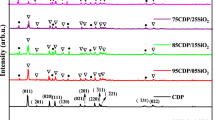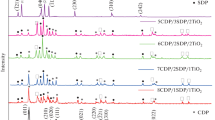Abstract
The influence of CsHSO4 inorganic solid acid was evaluated as a possible proton conductor in the catalyst layer of ABPBI (poly(2,5-benzimidazole))-based high-temperature polymer electrolyte membrane fuel cells (HT-PEMFCs). Gas diffusion electrodes (GDEs) were prepared with fixed polytetrafluoroethylene (PTFE) and polyvinylidene diflouride (PVDF) binder content, while the CsHSO4 loading was varied. Porosimetry data showed that the addition of 10 % CsHSO4 to the PVDF GDE increased the porosity across all the pore regions, whereas the addition of 10 % CsHSO4 to the PTFE GDE decreased the GDEs porosity. The CsHSO4 MEAs showed good proton transfer dynamics and low resistance for fuel cell operation. An optimum loading of 10 % CsHSO4 in conjunction with either of the binders was observed, with CsHSO4–PVDF GDE achieving peak power of 498.2 mW cm−2 at a cell voltage of +352 mV. Higher CsHSO4 loadings increased the charge transfer resistance and lowered the cell performance of these GDEs.





Similar content being viewed by others
References
Freire T, Gonzalez ER (2001) Effect of membrane characteristics and humidification conditions on the impedance response of polymer electrolyte membrane fuel cells. J Electroanal Chem 503:57–68
Oono Y, Fukuda T, Sounai A, Hori M (2010) Influence of operating temperature on cell performance and endurance of high temperature proton exchange membrane fuel cells. J Power Sour 195:1007–1014
Krishnan P, Park J-S, Kim C-S (2006) Performance of a poly(2,5-benzimidazole) membrane based high temperature PEM fuel cell in the presence of carbon monoxide. J Power Sour 159(2):817–823
Wainright JS, Wang JT, Weng D, Savinell RF, Litt M (1995) Acid-doped polybenzimidazoles: a new polymer electrolyte. J Electrochem Soc 142(7):L121–L123
Weng D, Wainright JS, Landau U, Savinell RF (1996) Electro-osmotic drag coefficient of water and methanol in polymer electrolytes at elevated temperatures. J Electrochem Soc 143(4):1260–1263
Wannek C, Lehnert W, Mergel J (2009) Membrane electrode assemblies for high-temperature polymer electrolyte fuel cells based on poly(2,5-benzimidazole) membranes with phosphoric acid impregnation via the catalyst layers. J Power Sour 192(2):258–266
Kwon K, Kim TY, Yoo DY, Hong S-G, Park JO (2009) Maximization of high-temperature proton exchange membrane fuel cell performance with the optimum distribution of phosphoric acid. J Power Sour 188(2):463–467
Wang J-T, Savinell RF, Wainright J, Litt M, Yu H (1996) A H2/O2 fuel cell using acid doped polybenzimidazole as polymer electrolyte. Electrochim Acta 41(2):193–197
Linares JJ, Sánches C, Paganin VA, González ER (2011) Poly(2,5-benzimidazole) membranes: physico-chemical characterization and high temperature PEMFC application. In: 11th polymer electrolyte fuel cell symposium, PEFC 11–220th ECS Meeting, Boston. pp 1579–1593
Asensio J (2004) Proton-conducting membranes based on poly(2,5-benzimidazole) (ABPBI) and phosphoric acid prepared by direct acid casting. J Membr Sci 241(1):89–93
Asensio J, Gómez-Romero P (2005) Recent developments on proton conducting poly(2,5-benzimidazole) (ABPBI) membrane for high temperature polymer electrolyte membrane fuel cells. Fuel Cells 5(3):336–343
Qingfeng L, Hjuler HA, Bjerrum NJ (2000) Oxygen reduction on carbon supported platinum catalysts in high temperature polymer electrolytes. Electrochim Acta 45:4219–4226
Lobato J, Cañizares P, Rodrigo MA, Linares JJ (2007) PBI-based polymer electrolyte membranes fuel cells Temperature effects on cell performance and catalyst stability. Electrochim Acta 52(12):3910–3920
Oh H-S, Lee J-H, Kim H (2012) Electrochemical carbon corrosion in high temperature proton exchange membrane fuel cells. Int J Hydrogen Energy 37(14):10844–10849
Angioni S, Righetti PP, Quartarone E, Dilena E, Mustarelli P, Magistris A (2011) Novel aryloxy-polybenzimidazoles as proton conducting membranes for high temperature PEMFCs. Int J Hydrogen Energy 36(12):7174–7182
Asensio JA, Borrós S, Gómez-Romero P (2003) Enhanced conductivity in polyanion-containing polybenzimidazoles. Improved materials for proton-exchange membranes and PEM fuel cells. Electrochem Commun 5(11):967–972
Carollo A, Quartarone E, Tomasi C, Mustarelli P, Belotti F, Magistris A, Maestroni F, Parachini M, Garlaschelli L, Righetti PP (2006) Developments of new proton conducting membranes based on different polybenzimidazole structures for fuel cells applications. J Power Sour 160(1):175–180
Lobato J, Cañizares P, Rodrigo MA, Úbeda D, Pinar FJ (2011) Enhancement of the fuel cell performance of a high temperature proton exchange membrane fuel cell running with titanium composite polybenzimidazole-based membranes. J Power Sour 196:8265–8271
Kumbharkar SC, Islam MN, Potrekar RA, Kharul UK (2009) Variation in acid moiety of polybenzimidazoles: investigation of physico-chemical properties towards their applicability as proton exchange and gas separation membrane materials. Polymer 50(6):1403–1413
Li M, Scott K (2010) A polymer electrolyte membrane for high temperature fuel cells to fit vehicle applications. Electrochim Acta 55(6):2123–2128
Wang RF, Liao SJ, Fu ZY, Ji S (2008) Platinum free ternary electrocatalysts prepared via organic colloidal method for oxygen reduction. Electrochem Commun 10(4):523–526
Hasiotis C, Deimede V, Kontoyannis C (2001) New polymer electrolytes based on blends of sulfonated polysulfones with polybenzimidazole. Electrochim Acta 46:2401–2406
Pinar FJ, Cañizares P, Rodrigo MA, Ubeda D, Lobato J (2012) Titanium composite PBI-based membranes for high temperature polymer electrolyte membrane fuel cells. Effect on titanium dioxide amount. RSC Adv 2(4):1547
Linares JJ, Sanches C, Paganin VA, Gonzalez ER (2012) Poly(2,5-bibenzimidazole) membranes: physico-chemical characterization focused on fuel cell applications. J Electrochem Soc 159(7):F194–F202
Fujigaya T, Okamoto M, Nakashima N (2009) Design of an assembly of pyridine-containing polybenzimidazole, carbon nanotubes and Pt nanoparticles for a fuel cell electrocatalyst with a high electrochemically active surface area. Carbon 47(14):3227–3232
Jin YC, Okada M, Hibino T (2011) A comparative study of Pt/C cathodes in Sn0.9In0.1P2O7 and H3PO4 ionomers for high-temperature proton exchange membrane fuel cells. J Power Sour 196(11):4905–4910
Li H, Liao SJ (2009) Preparation of large Co nanosheets with enhanced coercivity by a magnetic-field-assisted solvothermal approach free of surfactants, complexants or templates. J Magn Magn Mater 321(17):2566–2570
Pan C, Li Q, Jensen JO, He R, Cleemann LN, Nilsson MS, Bjerrum NJ, Zeng Q (2007) Preparation and operation of gas diffusion electrodes for high-temperature proton exchange membrane fuel cells. J Power Sour 172(1):278–286
Mazúr P, Soukop J, Paidar M, Bouzek K (2011) Gas diffusion electrodes for high temperature PEM type fuel cells-role of a polymer binder and method of the catalyst layer deposition. J Appl Electrochem 41:1013–1019
Lobato J, Cañizares P, Rodrigo MA, Linares JJ, Pinar FJ (2010) Study of the influence of the amount of PBI–H3PO4 in the catalytic layer of a high temperature PEMFC. Int J Hydrogen Energy 35(3):1347–1355
Oono Y, Sounai A, Hori M (2009) Influence of the phosphoric acid-doping level in a polybenzimidazole membrane on the cell performance of high-temperature proton exchange membrane fuel cells. J Power Sour 189(2):943–949
Su H, Pasupathi S, Bladergroen B, Linkov V, Pollet BG (2013) Optimization of gas diffusion electrode for polybenzimidazole-based high temperature proton exchange membrane fuel cell: evaluation of polymer binders in catalyst layer. Int J Hydrogen Energy 38(26):11370–11378
Felix C, Jao T-C, Pasupathi S, Pollet BG (2013) Optimisation of electrophoretic deposition parameters for gas diffusion electrodes in high temperature polymer electrolyte membrane fuel cells. J Power Sour 243:40–47
Higuchi E, Okamoto K, Miyatake K, Uchida H, Watanabe M (2006) Gas diffusion electrodes for polymer electrolyte fuel cell using sulfonated polyimide. Res Chem Intermed 32(5–6):533–542
Lobato J, Cañizares P, Rodrigo MA, Úbeda D, Pinar FJ, Linares JJ (2010) Optimisation of the microporous layer for a polybenzimidazole-based high temperature PEMFC. Effect of carbon content. Fuel Cells 10(5):770
Park JO, Kwon K, Cho MD, Hong S-G, Kim TY, Yoo DY (2011) Role of binders in high temperature PEMFC electrode. J Electrochem Soc 158(6):B675–B681
Haile SM, Boysen DA, Chisholm C, Merle RB (2001) Solid acids as fuel cell electrolytes. Nature 410:910–913
Lavrova G, Russkih M, Ponomareva V, Uvarov N (2006) Intermediate-temperature fuel cell based on the proton-conducting composite membranes. Solid State Ion 177(19–25):2129–2132
Piao J, Liao S, Liang Z (2009) A novel cesium hydrogen sulfate–zeolite inorganic composite electrolyte membrane for polymer electrolyte membrane fuel cell application. J Power Sour 193(2):483–487
Lee H-K, Park J-H, Kim D-Y, Lee T-H (2004) A study on the characteristics of the diffusion layer thickness and porosity of the PEMFC. J Power Sour 131(1–2):200–206
Yuan X, Wang H, Colinsun J, Zhang J (2007) AC impedance technique in PEM fuel cell diagnosis—a review. Int J Hydrogen Energy 32(17):4365–4380
Kim J-R, Yi JS, Song T-W (2012) Investigation of degradation mechanisms of a high-temperature polymer-electrolyte-membrane fuel cell stack by electrochemical impedance spectroscopy. J Power Sour 220:54–64
Acknowledgments
This work is supported by Hydrogen and Fuel Cell Technologies RDI Programme (HySA), funded by the Department of Science and Technology in South Africa, project KP1S01.
Author information
Authors and Affiliations
Corresponding author
Rights and permissions
About this article
Cite this article
Barron, O., Su, H., Linkov, V. et al. CsHSO4 as proton conductor for high-temperature polymer electrolyte membrane fuel cells. J Appl Electrochem 44, 1037–1045 (2014). https://doi.org/10.1007/s10800-014-0715-x
Received:
Accepted:
Published:
Issue Date:
DOI: https://doi.org/10.1007/s10800-014-0715-x




